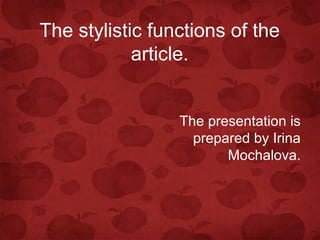The stylistic functions of the article
- 1. The stylistic functions of the article. The presentation is prepared by Irina Mochalova.
- 2. ? The definite article is used with common names in organizing the metaphors. In our example the definite article defines the connection of the word with the context. ? I will o¡¯ertake thee, Cleopatra, ? And weep for my pardon. So it must be, for now ? All length is torture! Since the torch is out. ? (W. Shakespeare).
- 3. ? Sometimes the nouns that are commonly used with the definite article can be used with the indefinite one and as a result of it they get the meaning ?one of the possible?: ? A moon was up, had severed all connection with the chimney pots of distant houses (A. Sillitoe).
- 4. ? Sometimes the rule of the usage the indefinite article with the objects first mentioned is violated. The things can be represented as already known to the listener or reader. Due to this he reaches vividness, emotion tension of the narrative. ? In the fall the war was always there, but we did not go it any more. It was cold in the fall in Milan and the dark came very early.
- 5. ? Using the definite article with a surname in plural or just a proper name serves to indicate emotions. ? I could hardly be blamed for all the skeletons of the MaGraths. (the negative attitude of the speaker towards the family mentioned.) ? She is refusing to cooperate with her lawyer, the nice-looking young Lloyd. (define the estimation.)
- 6. ? The usage of the articles depends also on the functional style of the text. Thus, in the advertisements published in the newspapers all the articles are omitted. It helps to create the telegram-like style: ? Trained nurse with child 2 years seeks post London preferred.







